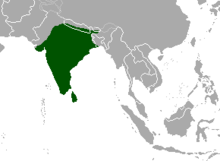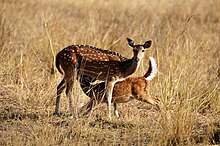Axis deer
| Axis deer | ||||||||||||
|---|---|---|---|---|---|---|---|---|---|---|---|---|

Axis deer in Kerala , India |
||||||||||||
| Systematics | ||||||||||||
|
||||||||||||
| Scientific name | ||||||||||||
| Axis axis | ||||||||||||
| ( Erxleben , 1777) |
The axis deer or chital ( Axis axis ) is in India , Nepal and Sri Lanka widespread Hirsch . Like all members of the genus of the axis deer , this species also has a conspicuous, spotted coat all year round. However, the contrast between the white spots and the otherwise red-brown fur is stronger than is the case with other deer.
features
Like the fallow deer and the sika deer , the axis deer wears a spotted dress for life. The white spots stand in particularly sharp contrast to the red-brown fur. The abdomen and legs are colored white. With a head body length of 140 cm, a body height of 80 cm and a weight of 100 kg, it is slightly smaller than a fallow deer and much smaller than a red deer , but larger than a deer . The legs and the body are slim, the height at the withers is about 95 cm, the tail length about 25 cm. Due to the tropical habitat, axis deer do not develop winter coat with a different coat color. However, the coat is shinier, thicker and a little darker in winter than in summer.
As with all Axis deer, the antlers are relatively unique. It has three ends, the antlers bend first back and then forward again. The eye and middle rung arise from the antler rod at an angle of 90 degrees and are bent vertically upwards at the tip. The antler rod measures 76 and 96 centimeters. Since the axis deer is a tropical species of deer, the period of antler dropping and growth can not be precisely limited. Deer from the same habitat have antlers in different growth phases.
The Axishirsch is extremely happy to call. The sound repertoire includes rough bells and a throaty but high-pitched growl. The frightening sounds of the female are also barking sounds. They can also be heard when the male drives them during the rutting season.
distribution
The natural range includes India, southern Nepal and the island of Sri Lanka . Here the axis deer lives in open terrain and tree-covered bushland, but avoids dense forests.
The population of the axis deer is not endangered.
The axis deer was also introduced by humans to numerous regions of the world in which it was not originally native, for example in the southern USA , Hawaii , South America , Croatia and the Andaman Islands . In New Zealand , too , where humans naturalized a total of seven species of deer for hunting purposes, they were once made at home, but are now apparently extinct again. Naturalization attempts in England and Germany always failed because the Axishirsch did not tolerate the cold climate.
Way of life
Axis deer live in groups of five to ten animals. Under favorable conditions, large herds form, which can contain over a hundred individuals. The composition of the herds is constantly changing. Males, females and juveniles join these groups. Even during the mating season, when males display highly aggressive behavior in other deer species, the male axis deer tolerate members of their own sex in the herd. However, they will defend a female with whom they want to mate against other males.
They mostly graze on grassland that borders directly on the forest and into which they can take refuge if they are disturbed. Axis deer benefit when domestic cattle are present on their foraging areas, as cattle eat the rougher, longer grasses, while axis deer prefer the young and tender shoots. In addition, they also eat agricultural crops, fallen fruits and flowers. Axis deer cause significant forest damage as the males mark trees by chopping off the outer bark from the tree trunks by sweeping the antlers, exposing the white, inner bark. Axis deer remove the bark from almost every tree in the forest areas bordering the Äsflächen. Very often this causes the trees to die. Axis deer prevent their grazing areas from becoming bushy and turning into forest.
Reproduction
The offspring are born on average after a gestation period of 230 days, whereby the mating times are not dependent on the weather. With most axis deer, only one young is born, twins are a rare occurrence. Deer calves have spotted fur from birth. They grow up very quickly and the female young are ready to conceive when they are 12 months old.
Predators
Tigers and red dogs are among the most important predators of the axis deer . Red dogs usually hunt in packs and axis deer usually flee from them; occasionally, however, axis deer attack them using their antlers and their forelegs. Axis deer, on the other hand, can only flee from the tiger. They therefore react immediately to warning calls from birds and monkeys, which could indicate an approaching tiger. They usually try to keep so much distance from the tiger that further approach is pointless for it. All four species are also eaten by pythons found in their respective habitats.
The axis deer shows a particular behavioral adaptation in the regions where tigers and red dogs occur. Since they have learned that both species avoid collisions with humans, they tend to be on the outskirts of villages. At night they occasionally even come to the villages and mingle with the domestic cattle.
literature
- Ronald M. Nowak: Walker's Mammals of the World . Johns Hopkins University Press, 1999, ISBN 0-8018-5789-9
- Leonard Lee Rue III: The Encyclopedia of Deer . Voyageur Press, Stillwater 2003, ISBN 0-89658-590-5
- Tej Kumar Shrestha: Wildlife of Nepal - A Study of Renewable Resources of Nepal Himalayas. Tribhuvan University, Kathmandu 2003, ISBN 99933-59-02-5
Web links
- Axis axis in the endangered Red List species the IUCN 2006. Posted by: Deer Specialist Group, 1996. Retrieved on 12 May, 2006.




